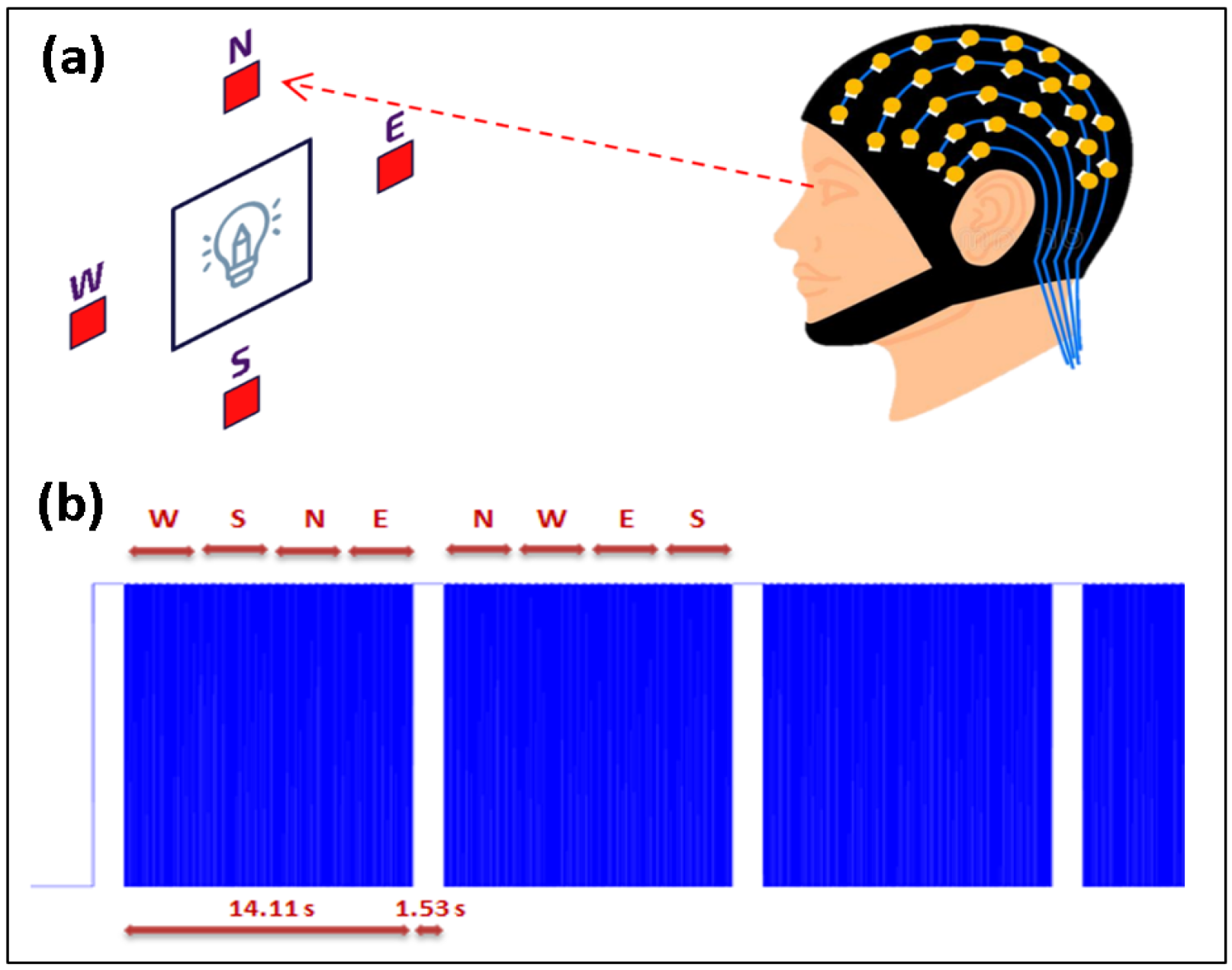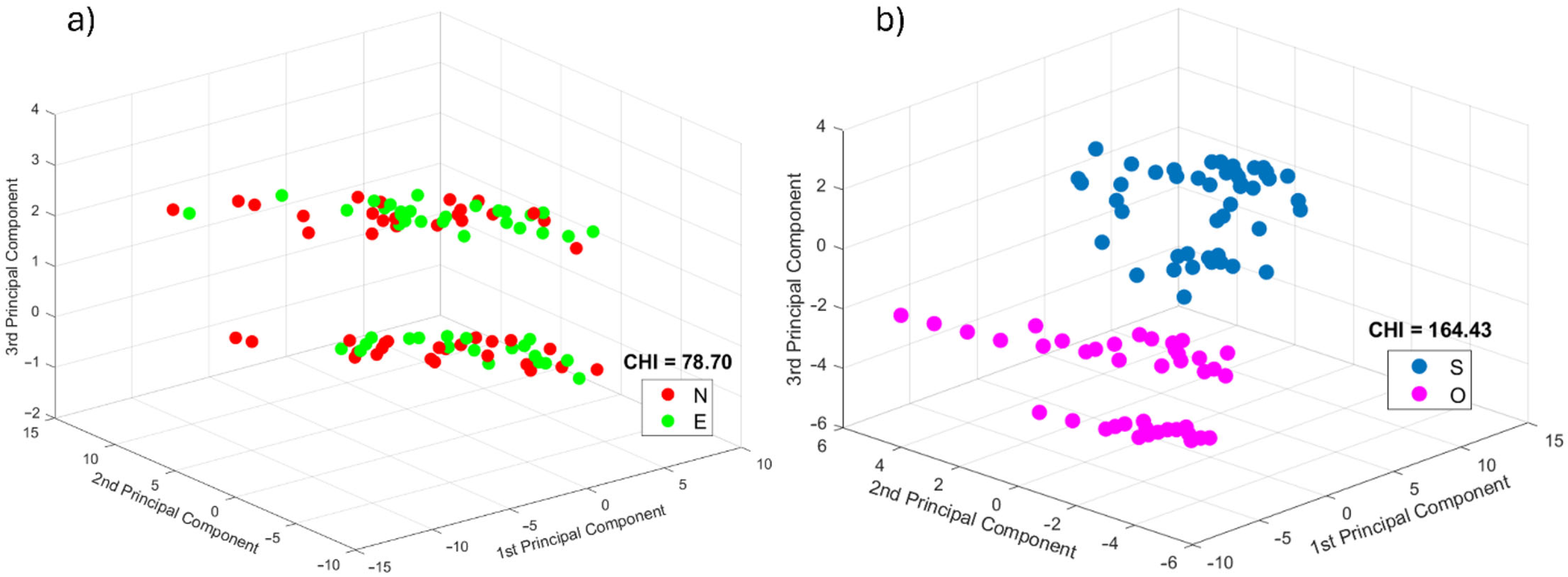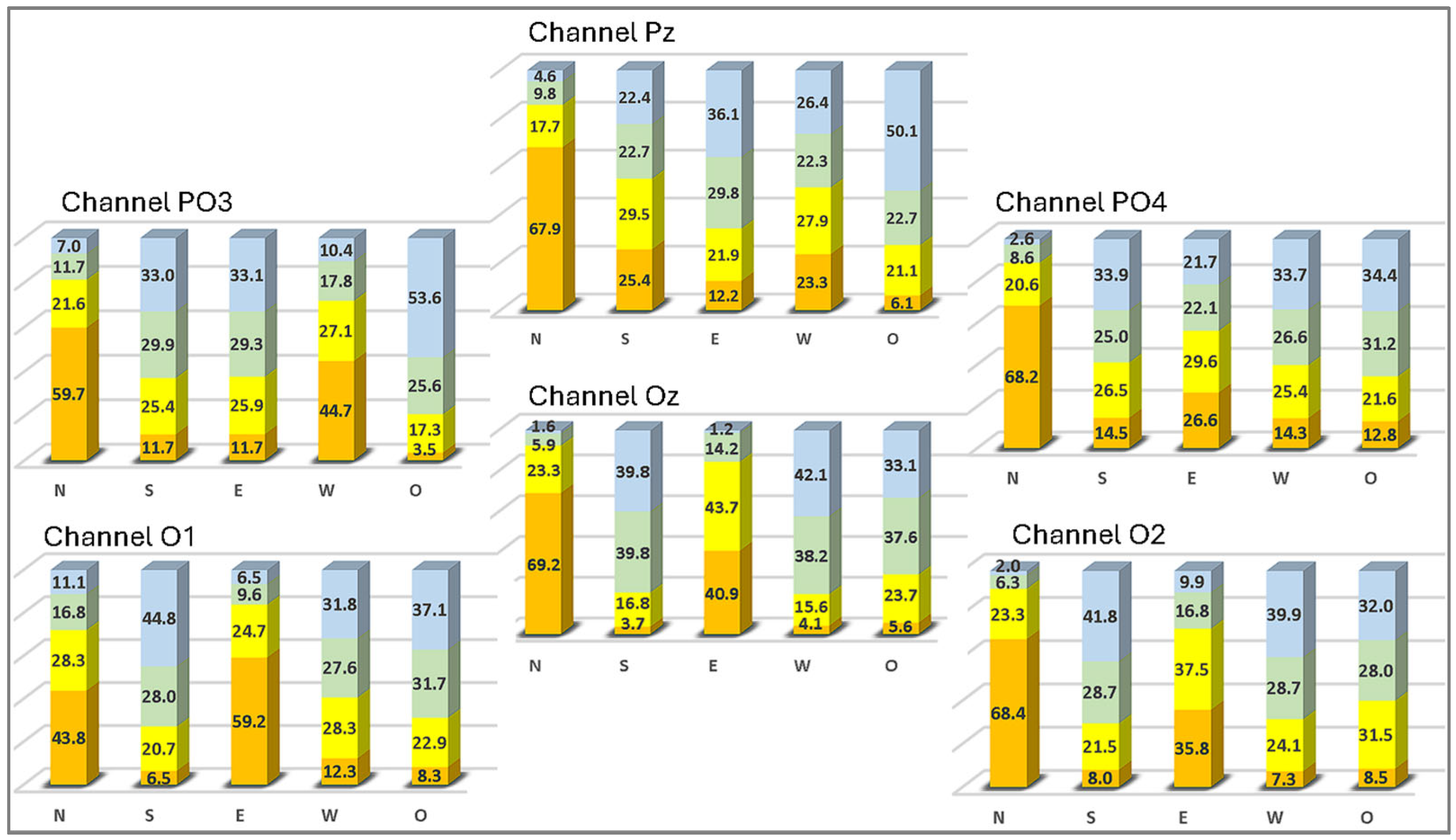Performance of a Single-Flicker SSVEP BCI Using Single Channels †
Abstract
1. Introduction
2. Materials and Methods
2.1. Data Acquisition and Experimental Protocol
2.2. EEG Recordings and Data Processing
- High: Energy greater than or equal to the third quartile (Q3).
- Medium: Energy between the second and third quartile (Q2–Q3).
- Low: Energy between the first and second quartile (Q1–Q2).
- Very Low: Energy lower than the first quartile (Q1).
3. Results and Discussion
4. Conclusions
Author Contributions
Funding
Institutional Review Board Statement
Informed Consent Statement
Data Availability Statement
Conflicts of Interest
References
- Zhu, D.; Bieger, J.; Molina, G.G.; Aarts, R.M. A survey of stimulation methods used in SSVEP-based BCIs. Comput. Intell. Neurosci. 2010, 2010, 702357. [Google Scholar] [CrossRef] [PubMed]
- Zhang, Y.; Xie, S.Q.; Wang, H.; Zhang, Z. Data Analytics in Steady-State Visual Evoked Potential-Based Brain–Computer Interface: A Review. IEEE Sens. J. 2021, 21, 1124–1138. [Google Scholar] [CrossRef]
- Tsoneva, T.; Garcia-Molina, G.; Desain, P. SSVEP phase synchronies and propagation during repetitive visual stimulation at high frequencies. Sci. Rep. 2021, 11, 4975. [Google Scholar] [CrossRef] [PubMed]
- Duart, X.; Quiles, E.; Suay, F.; Chio, N.; García, E.; Morant, F. Evaluating the Effect of Stimuli Color and Frequency on SSVEP. Sensors 2020, 21, 117. [Google Scholar] [CrossRef] [PubMed]
- Chen, J.; Zhang, D.; Engel, A.K.; Gong, Q.; Maye, A. Application of a single-flicker online SSVEP BCI for spatial navigation. PLoS ONE 2017, 12, e0178385. [Google Scholar] [CrossRef] [PubMed]
- Sharma, K.; Kar, S. Extracting multiple commands from a single SSVEP flicker using eye-accommodation. Biocybern. Biomed. Eng. 2019, 39, 914–922. [Google Scholar] [CrossRef]
- Lan, W.; Wang, R.; He, Y.; Zong, Y.; Leng, Y.; Iramina, K.; Zheng, W.; Ge, S. Cross Domain Correlation Maximization for Enhancing the Target Recognition of SSVEP-Based Brain–Computer Interfaces. IEEE Trans. Neural Syst. Rehabil. Eng. 2023, 31, 3545–3555. [Google Scholar] [CrossRef] [PubMed]
- Maulik, U.; Bandyopadhyay, S. Performance evaluation of some clustering algorithms and validity indices. IEEE Trans. Pattern Anal. Mach. Intell. 2002, 24, 1650–1654. [Google Scholar] [CrossRef]



| Channel | NvsS | NvsE | NvsW | NvsO | SvsE | SvsW | SvsO | EvsW | EvsO | WvsO |
|---|---|---|---|---|---|---|---|---|---|---|
| Oz | 179.80 | 132.14 | 214.38 | 273.93 | 113.19 | 82.94 | 27.72 | 117.74 | 107.26 | 64.97 |
| O1 | 89.91 | 104.93 | 93.17 | 102.87 | 135.09 | 69.76 | 57.71 | 121.65 | 162.05 | 37.87 |
| O2 | 172.37 | 126.56 | 186.52 | 256.93 | 89.72 | 104.22 | 76.42 | 77.51 | 69.40 | 55.90 |
| PO3 | 144.02 | 141.34 | 105.91 | 198.87 | 65.85 | 95.92 | 40.69 | 98.24 | 30.11 | 109.38 |
| PO4 | 127.56 | 119.26 | 128.64 | 217.97 | 69.55 | 72.38 | 44.11 | 57.63 | 46.00 | 33.41 |
| Pz | 147.12 | 204.21 | 122.86 | 263.04 | 74.94 | 61.77 | 54.94 | 61.51 | 41.50 | 18.50 |
Disclaimer/Publisher’s Note: The statements, opinions and data contained in all publications are solely those of the individual author(s) and contributor(s) and not of MDPI and/or the editor(s). MDPI and/or the editor(s) disclaim responsibility for any injury to people or property resulting from any ideas, methods, instructions or products referred to in the content. |
© 2025 by the authors. Licensee MDPI, Basel, Switzerland. This article is an open access article distributed under the terms and conditions of the Creative Commons Attribution (CC BY) license (https://creativecommons.org/licenses/by/4.0/).
Share and Cite
Padilla, G.L.; Farfán, F.D. Performance of a Single-Flicker SSVEP BCI Using Single Channels. Eng. Proc. 2024, 81, 19. https://doi.org/10.3390/engproc2024081019
Padilla GL, Farfán FD. Performance of a Single-Flicker SSVEP BCI Using Single Channels. Engineering Proceedings. 2024; 81(1):19. https://doi.org/10.3390/engproc2024081019
Chicago/Turabian StylePadilla, Gerardo Luis, and Fernando Daniel Farfán. 2024. "Performance of a Single-Flicker SSVEP BCI Using Single Channels" Engineering Proceedings 81, no. 1: 19. https://doi.org/10.3390/engproc2024081019
APA StylePadilla, G. L., & Farfán, F. D. (2024). Performance of a Single-Flicker SSVEP BCI Using Single Channels. Engineering Proceedings, 81(1), 19. https://doi.org/10.3390/engproc2024081019







